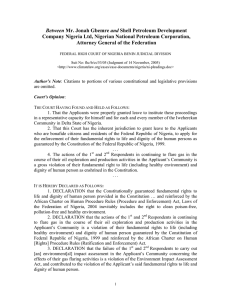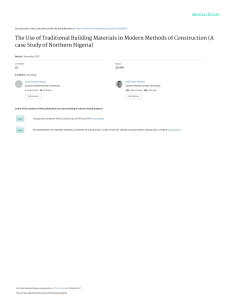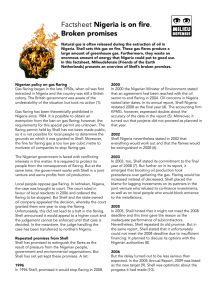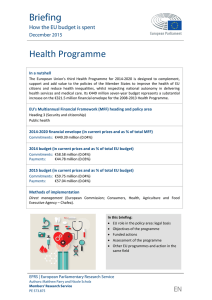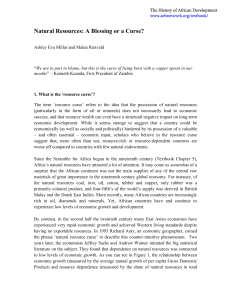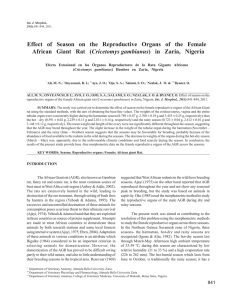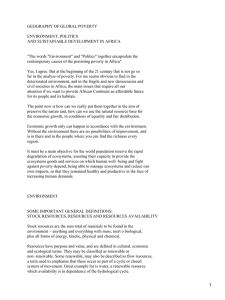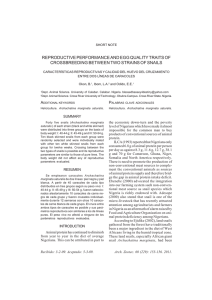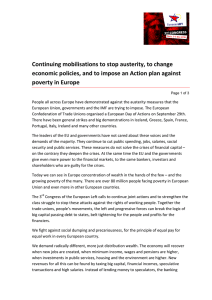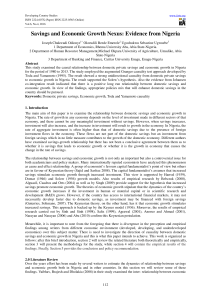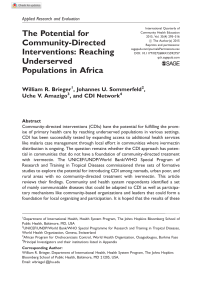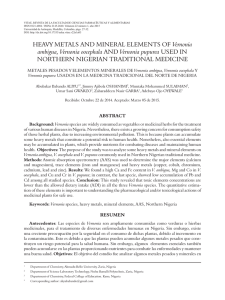Briefing European Parliamentary Research Service
Anuncio
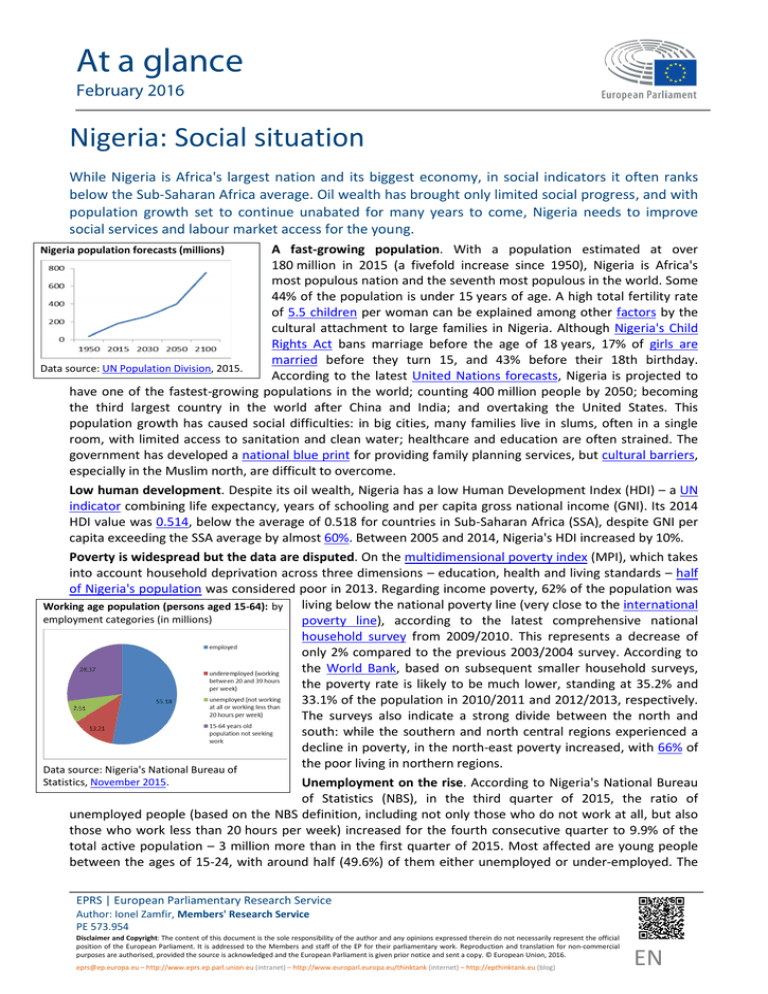
At a glance February 2016 Nigeria: Social situation While Nigeria is Africa's largest nation and its biggest economy, in social indicators it often ranks below the Sub-Saharan Africa average. Oil wealth has brought only limited social progress, and with population growth set to continue unabated for many years to come, Nigeria needs to improve social services and labour market access for the young. A fast-growing population. With a population estimated at over 180 million in 2015 (a fivefold increase since 1950), Nigeria is Africa's most populous nation and the seventh most populous in the world. Some 44% of the population is under 15 years of age. A high total fertility rate of 5.5 children per woman can be explained among other factors by the cultural attachment to large families in Nigeria. Although Nigeria's Child Rights Act bans marriage before the age of 18 years, 17% of girls are married before they turn 15, and 43% before their 18th birthday. Data source: UN Population Division, 2015. According to the latest United Nations forecasts, Nigeria is projected to have one of the fastest-growing populations in the world; counting 400 million people by 2050; becoming the third largest country in the world after China and India; and overtaking the United States. This population growth has caused social difficulties: in big cities, many families live in slums, often in a single room, with limited access to sanitation and clean water; healthcare and education are often strained. The government has developed a national blue print for providing family planning services, but cultural barriers, especially in the Muslim north, are difficult to overcome. Low human development. Despite its oil wealth, Nigeria has a low Human Development Index (HDI) – a UN indicator combining life expectancy, years of schooling and per capita gross national income (GNI). Its 2014 HDI value was 0.514, below the average of 0.518 for countries in Sub-Saharan Africa (SSA), despite GNI per capita exceeding the SSA average by almost 60%. Between 2005 and 2014, Nigeria's HDI increased by 10%. Poverty is widespread but the data are disputed. On the multidimensional poverty index (MPI), which takes into account household deprivation across three dimensions – education, health and living standards – half of Nigeria's population was considered poor in 2013. Regarding income poverty, 62% of the population was living below the national poverty line (very close to the international Working age population (persons aged 15‐64): by employment categories (in millions) poverty line), according to the latest comprehensive national household survey from 2009/2010. This represents a decrease of only 2% compared to the previous 2003/2004 survey. According to the World Bank, based on subsequent smaller household surveys, the poverty rate is likely to be much lower, standing at 35.2% and 33.1% of the population in 2010/2011 and 2012/2013, respectively. The surveys also indicate a strong divide between the north and south: while the southern and north central regions experienced a decline in poverty, in the north-east poverty increased, with 66% of the poor living in northern regions. Data source: Nigeria's National Bureau of Statistics, November 2015. Unemployment on the rise. According to Nigeria's National Bureau of Statistics (NBS), in the third quarter of 2015, the ratio of unemployed people (based on the NBS definition, including not only those who do not work at all, but also those who work less than 20 hours per week) increased for the fourth consecutive quarter to 9.9% of the total active population – 3 million more than in the first quarter of 2015. Most affected are young people between the ages of 15-24, with around half (49.6%) of them either unemployed or under-employed. The Nigeria population forecasts (millions) EPRS | European Parliamentary Research Service Author: Ionel Zamfir, Members' Research Service PE 573.954 Disclaimer and Copyright: The content of this document is the sole responsibility of the author and any opinions expressed therein do not necessarily represent the official position of the European Parliament. It is addressed to the Members and staff of the EP for their parliamentary work. Reproduction and translation for non-commercial purposes are authorised, provided the source is acknowledged and the European Parliament is given prior notice and sent a copy. © European Union, 2016. [email protected] – http://www.eprs.ep.parl.union.eu (intranet) – http://www.europarl.europa.eu/thinktank (internet) – http://epthinktank.eu (blog) EN EPRS Nigeria: Social situation unemployment rate may appear low; in fact, few Nigerians can afford not to work at all; many of them are engaged in informal, low-pay, low-productivity activities, according to the World Bank. Of the jobs created in the third quarter of 2015, 90% were in the informal sector. The problem of youth unemployment is difficult to tackle, with 2 million entering the job market every year. In the current difficult economic context, youth unemployment is an issue of urgent concern, as it fuels criminality and contributes to social unrest. Many children not in education. Education in Nigeria is the shared responsibility of the Youth Primary literacy rate school net federal, state and local governments. The education sector is divided into three sub(% – 15-24 enrolment sectors: basic (nine years), senior secondary (three years), and tertiary. Nigeria was years) ratio (%) unable to fulfil the Millennium Development Goal of securing primary education for all children by 2015. According to Unesco, Nigeria has the highest population of out-ofschool children in the world (almost nine million in 2010). In the northern regions, primary school attendance is almost half that in the southern regions and there is a significant gender gap in primary school attendance. In the north, many, particularly poor, children attend informal Islamic (Almajiri) schools, whose curricula are not regulated by public authorities; the children attending such schools live away from their families and are exposed to psychological and economic hardship, making them vulnerable, for example, to recruitment by Boko Haram. Violence caused by Source: Unicef, 2013. Boko Haram in Nigeria's north-eastern regions has driven many children out of school; approximately 600 teachers have been killed, while many others fled, profoundly disrupting education. Nigeria's 128 universities (as of 2013) cannot cope with demand, and each year only around one third of applicants are admitted, based on a centralised exam. At tertiary level, the number of students has grown from under 15 000 in 1970 to 1.2 million in 2013. Health. One in ten children dies before the age of five, making Nigeria one of the countries with the highest mortality rates of children under five in the world. Nigeria provides healthcare coverage to only 3% of its population through the National Health Insurance Scheme (NHIS) enacted in 1999. The scheme mainly covers federal public sector workers and their families, although it is supposed to achieve universal health coverage. Nigeria's health indicators have either stagnated or worsened during the past decade, despite federal government efforts to improve healthcare. Life expectancy, at 52 years, is below the African average. Access to electricity, water and HIV, tuberculosis and malaria are among the leading causes of death, accounting sanitation (% of population) together for around 20% of total deaths. While the percentage of population using improved drinking water sources has increased since 1990 to around 60%, the percentage of the population with access to improved sanitation facilities has decreased to only around 30%. A positive signal was Nigeria's swift and efficient response to the Ebola epidemics in 2014, revealing a robust health system able to deal with emergencies, prompting the World Health Organization to declare the Source: World Bank. Nigerian authorities' timely action 'world-class epidemiological detective work'. Environmental degradation. Repeated oil pollution in the Niger Delta, a major oil extraction region, represents a grave and persistent environmental problem, affecting the livelihoods of local communities. While oil companies consider that most oil spills are caused by oil thefts and sabotage, NGOs claim that poor infrastructure and operational failures, for which oil companies and the government are largely responsible, also play an important role. A UN Environmental Programme report on the state of oil pollution in Ogoniland, one of the most polluted areas in the Niger Delta, found extensive soil and water contamination, posing a serious threat to the local population's health, and concluded that environmental restoration of the region would take 25 to 30 years. Deforestation and desertification are major environmental problems in Nigeria. The UN Food and Agriculture Organization (FAO) estimates that only 10.6% of the country's surface remained covered by forests and wooded land in 2015. Due to the expansion of smallholder agriculture, infrastructural and real estate development and the use of wood for cooking, 400 000 hectare of forest disappear annually. Between 1990 and 2015, Nigeria had the second highest rate of forest loss in the world: with forest area shrinking by 60%. The primary forest, which counted 1.5 million hectare in 1990, has almost disappeared, with only 20 000 hectare remaining. As a result of climatic variability and human activity, 15% of the country is prone to desertification; 35 000 hectare of arable land are lost to desert every year. See also complementary EPRS notes on the human rights, political, economic and security situation in Nigeria. Members' Research Service Page 2 of 2
